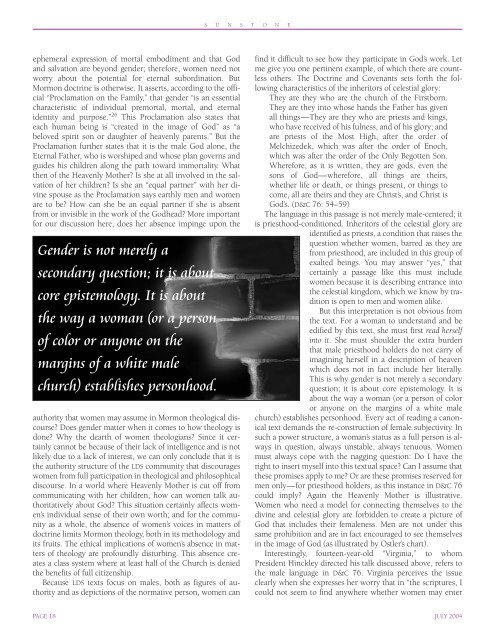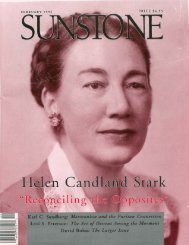is there a place for heavenly mother in mormon theology?
is there a place for heavenly mother in mormon theology?
is there a place for heavenly mother in mormon theology?
You also want an ePaper? Increase the reach of your titles
YUMPU automatically turns print PDFs into web optimized ePapers that Google loves.
S U N S T O N E<br />
ephemeral expression of mortal embodiment and that God<br />
and salvation are beyond gender; <strong>there</strong><strong>for</strong>e, women need not<br />
worry about the potential <strong>for</strong> eternal subord<strong>in</strong>ation. But<br />
Mormon doctr<strong>in</strong>e <strong>is</strong> otherw<strong>is</strong>e. It asserts, accord<strong>in</strong>g to the official<br />
“Proclamation on the Family,” that gender “<strong>is</strong> an essential<br />
character<strong>is</strong>tic of <strong>in</strong>dividual premortal, mortal, and eternal<br />
identity and purpose.” 26 Th<strong>is</strong> Proclamation also states that<br />
each human be<strong>in</strong>g <strong>is</strong> “created <strong>in</strong> the image of God” as “a<br />
beloved spirit son or daughter of <strong>heavenly</strong> parents.” But the<br />
Proclamation further states that it <strong>is</strong> the male God alone, the<br />
Eternal Father, who <strong>is</strong> worshiped and whose plan governs and<br />
guides h<strong>is</strong> children along the path toward immortality. What<br />
then of the Heavenly Mother? Is she at all <strong>in</strong>volved <strong>in</strong> the salvation<br />
of her children? Is she an “equal partner” with her div<strong>in</strong>e<br />
spouse as the Proclamation says earthly men and women<br />
are to be? How can she be an equal partner if she <strong>is</strong> absent<br />
from or <strong>in</strong>v<strong>is</strong>ible <strong>in</strong> the work of the Godhead? More important<br />
<strong>for</strong> our d<strong>is</strong>cussion here, does her absence imp<strong>in</strong>ge upon the<br />
Gender <strong>is</strong> not merely a<br />
secondary question; it <strong>is</strong> about<br />
core ep<strong>is</strong>temology. It <strong>is</strong> about<br />
the way a woman (or a person<br />
of color or anyone on the<br />
marg<strong>in</strong>s of a white male<br />
church) establ<strong>is</strong>hes personhood.<br />
authority that women may assume <strong>in</strong> Mormon theological d<strong>is</strong>course?<br />
Does gender matter when it comes to how <strong>theology</strong> <strong>is</strong><br />
done? Why the dearth of women theologians? S<strong>in</strong>ce it certa<strong>in</strong>ly<br />
cannot be because of their lack of <strong>in</strong>telligence and <strong>is</strong> not<br />
likely due to a lack of <strong>in</strong>terest, we can only conclude that it <strong>is</strong><br />
the authority structure of the LDS community that d<strong>is</strong>courages<br />
women from full participation <strong>in</strong> theological and philosophical<br />
d<strong>is</strong>course. In a world where Heavenly Mother <strong>is</strong> cut off from<br />
communicat<strong>in</strong>g with her children, how can women talk authoritatively<br />
about God? Th<strong>is</strong> situation certa<strong>in</strong>ly affects women’s<br />
<strong>in</strong>dividual sense of their own worth; and <strong>for</strong> the community<br />
as a whole, the absence of women’s voices <strong>in</strong> matters of<br />
doctr<strong>in</strong>e limits Mormon <strong>theology</strong>, both <strong>in</strong> its methodology and<br />
its fruits. The ethical implications of women’s absence <strong>in</strong> matters<br />
of <strong>theology</strong> are profoundly d<strong>is</strong>turb<strong>in</strong>g. Th<strong>is</strong> absence creates<br />
a class system where at least half of the Church <strong>is</strong> denied<br />
the benefits of full citizenship.<br />
Because LDS texts focus on males, both as figures of authority<br />
and as depictions of the normative person, women can<br />
f<strong>in</strong>d it difficult to see how they participate <strong>in</strong> God’s work. Let<br />
me give you one pert<strong>in</strong>ent example, of which <strong>there</strong> are countless<br />
others. The Doctr<strong>in</strong>e and Covenants sets <strong>for</strong>th the follow<strong>in</strong>g<br />
character<strong>is</strong>tics of the <strong>in</strong>heritors of celestial glory:<br />
They are they who are the church of the Firstborn.<br />
They are they <strong>in</strong>to whose hands the Father has given<br />
all th<strong>in</strong>gs—They are they who are priests and k<strong>in</strong>gs,<br />
who have received of h<strong>is</strong> fulness, and of h<strong>is</strong> glory; and<br />
are priests of the Most High, after the order of<br />
Melchizedek, which was after the order of Enoch,<br />
which was after the order of the Only Begotten Son.<br />
Where<strong>for</strong>e, as it <strong>is</strong> written, they are gods, even the<br />
sons of God—where<strong>for</strong>e, all th<strong>in</strong>gs are theirs,<br />
whether life or death, or th<strong>in</strong>gs present, or th<strong>in</strong>gs to<br />
come, all are theirs and they are Chr<strong>is</strong>t’s, and Chr<strong>is</strong>t <strong>is</strong><br />
God’s. (D&C 76: 54–59)<br />
The language <strong>in</strong> th<strong>is</strong> passage <strong>is</strong> not merely male-centered; it<br />
<strong>is</strong> priesthood-conditioned. Inheritors of the celestial glory are<br />
identified as priests, a condition that ra<strong>is</strong>es the<br />
question whether women, barred as they are<br />
from priesthood, are <strong>in</strong>cluded <strong>in</strong> th<strong>is</strong> group of<br />
exalted be<strong>in</strong>gs. You may answer “yes,” that<br />
certa<strong>in</strong>ly a passage like th<strong>is</strong> must <strong>in</strong>clude<br />
women because it <strong>is</strong> describ<strong>in</strong>g entrance <strong>in</strong>to<br />
the celestial k<strong>in</strong>gdom, which we know by tradition<br />
<strong>is</strong> open to men and women alike.<br />
But th<strong>is</strong> <strong>in</strong>terpretation <strong>is</strong> not obvious from<br />
the text. For a woman to understand and be<br />
edified by th<strong>is</strong> text, she must first read herself<br />
<strong>in</strong>to it. She must shoulder the extra burden<br />
that male priesthood holders do not carry of<br />
imag<strong>in</strong><strong>in</strong>g herself <strong>in</strong> a description of heaven<br />
which does not <strong>in</strong> fact <strong>in</strong>clude her literally.<br />
Th<strong>is</strong> <strong>is</strong> why gender <strong>is</strong> not merely a secondary<br />
question; it <strong>is</strong> about core ep<strong>is</strong>temology. It <strong>is</strong><br />
about the way a woman (or a person of color<br />
or anyone on the marg<strong>in</strong>s of a white male<br />
church) establ<strong>is</strong>hes personhood. Every act of read<strong>in</strong>g a canonical<br />
text demands the re-construction of female subjectivity. In<br />
such a power structure, a woman’s status as a full person <strong>is</strong> always<br />
<strong>in</strong> question, always unstable, always tenuous. Women<br />
must always cope with the nagg<strong>in</strong>g question: Do I have the<br />
right to <strong>in</strong>sert myself <strong>in</strong>to th<strong>is</strong> textual space? Can I assume that<br />
these prom<strong>is</strong>es apply to me? Or are these prom<strong>is</strong>es reserved <strong>for</strong><br />
men only—<strong>for</strong> priesthood holders, as th<strong>is</strong> <strong>in</strong>stance <strong>in</strong> D&C 76<br />
could imply? Aga<strong>in</strong> the Heavenly Mother <strong>is</strong> illustrative.<br />
Women who need a model <strong>for</strong> connect<strong>in</strong>g themselves to the<br />
div<strong>in</strong>e and celestial glory are <strong>for</strong>bidden to create a picture of<br />
God that <strong>in</strong>cludes their femaleness. Men are not under th<strong>is</strong><br />
same prohibition and are <strong>in</strong> fact encouraged to see themselves<br />
<strong>in</strong> the image of God (as illustrated by Ostler’s chart).<br />
Interest<strong>in</strong>gly, fourteen-year-old “Virg<strong>in</strong>ia,” to whom<br />
President H<strong>in</strong>ckley directed h<strong>is</strong> talk d<strong>is</strong>cussed above, refers to<br />
the male language <strong>in</strong> D&C 76. Virg<strong>in</strong>ia perceives the <strong>is</strong>sue<br />
clearly when she expresses her worry that <strong>in</strong> “the scriptures, I<br />
could not seem to f<strong>in</strong>d anywhere whether women may enter<br />
PAGE 18 JULY 2004
















